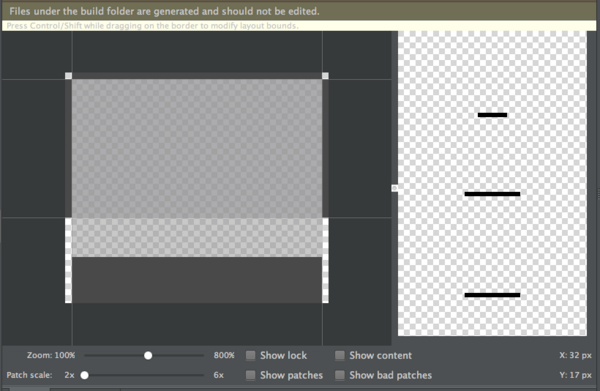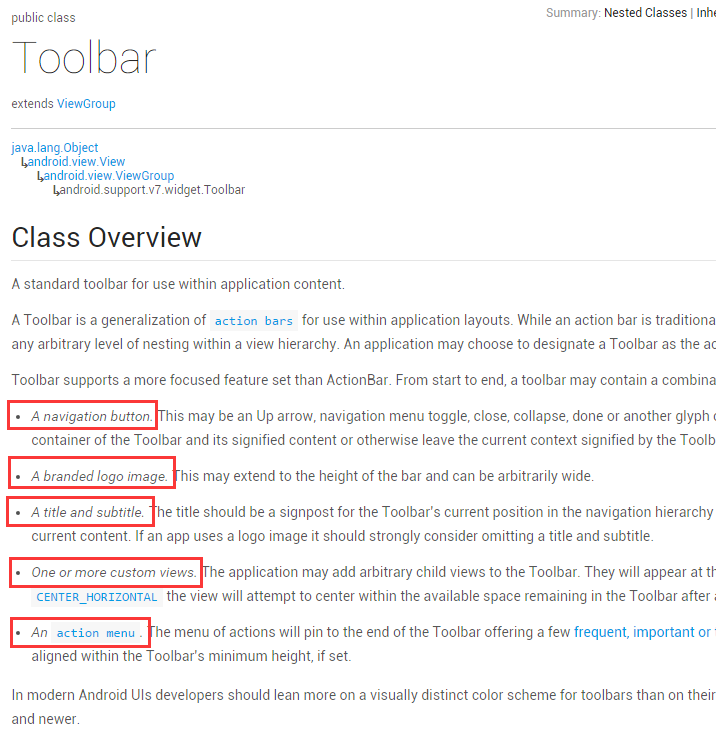編輯:Android資訊
當我開始接觸Tint這個詞的時候,其實是蠻不理解它的意思的,以及並不清楚Google發明它的目的,它一般搭配Background配合使用,但是現在已經有了Background,為什麼還需要Tint呢?
Tint 翻譯為著色。
著色,著什麼色呢?和背景有關,當然是著背景的色。當我開發客戶端,使用了appcompat-v7包的時候,為了實現Material Design的效果,我們會去設置主題裡的幾個顏色,重要的比如primaryColor,colorControlNormal,colorControlActived等等,而我們使用的一些組件,比如EditText就會自動變成我們想要的背景顏色,在背景圖只有一張的情況下,這樣的做法極大的減少了我們apk包的大小。
實現的方式就是用一個顏色為我們的背景圖片設置tint(著色)。

看看即將發布的SegmentFault for Android 2.7中,發布問題功能,這個EditText的顏色和我們的主要顏色相同。它利用了TintManager這個類,為自己的背景進行著色(綠色)。
那麼這個原始圖是什麼樣子呢?我們從appcompat-v7包中找到了這個圖,是一個.9圖,樣子如下:

其實它只是一個黑色的條,通過綠色的著色,變成了一個綠色的條。 就是這樣的設計方式,使得我們在Material Design中省了多少資源文件呀!
好了,既然理解了tint的含義,我們趕緊看下這一切是如何實現的吧。
其實底層特別簡單,了解過渲染的同學應該知道PorterDuffColorFilter這個東西,我們使用SRC_IN的方式,對這個Drawable進行顏色方面的渲染,就是在這個Drawable中有像素點的地方,再用我們的過濾器著色一次。
實際上如果要我們自己實現,只用獲取View的backgroundDrawable之後,設置下colorFilter即可。
看下最核心的代碼就這麼幾行
javaif (filter == null) {
// Cache miss, so create a color filter and add it to the cache
filter = new PorterDuffColorFilter(color, mode);
}
d.setColorFilter(filter);
通常情況下,我們的mode一般都是SRC_IN,如果想了解這個屬性相關的資料,這裡是傳送門: http://blog.csdn.net/t12x3456/article/details/10432935 (中文)
由於API Level 21以前不支持background tint在xml中設置,於是提供了ViewCompat.setBackgroundTintList方法和ViewCompat.setBackgroundTintMode用來手動更改需要著色的顏色,但要求相關的View繼承TintableBackgroundView接口。
看下源碼是如何實現的吧,我們以AppCompatEditText為例:
看下構造函數(省略無關代碼)
javapublic AppCompatEditText(Context context, AttributeSet attrs, int defStyleAttr) {
super(TintContextWrapper.wrap(context), attrs, defStyleAttr);
...
ColorStateList tint = a.getTintManager().getTintList(a.getResourceId(0, -1)); //根據背景的resource id獲取內置的著色顏色。
if (tint != null) {
setInternalBackgroundTint(tint); //設置著色
}
...
}
private void setInternalBackgroundTint(ColorStateList tint) {
if (tint != null) {
if (mInternalBackgroundTint == null) {
mInternalBackgroundTint = new TintInfo();
}
mInternalBackgroundTint.mTintList = tint;
mInternalBackgroundTint.mHasTintList = true;
} else {
mInternalBackgroundTint = null;
}
//上面的代碼是記錄tint相關的信息。
applySupportBackgroundTint(); //對背景應用tint
}
private void applySupportBackgroundTint() {
if (getBackground() != null) {
if (mBackgroundTint != null) {
TintManager.tintViewBackground(this, mBackgroundTint);
} else if (mInternalBackgroundTint != null) {
TintManager.tintViewBackground(this, mInternalBackgroundTint); //最重要的,對tint進行應用
}
}
}
然後我們進入tintViewBackground看下TintManager裡面的源碼
javapublic static void tintViewBackground(View view, TintInfo tint) {
final Drawable background = view.getBackground();
if (tint.mHasTintList) {
//如果設置了tint的話,對背景設置PorterDuffColorFilter
setPorterDuffColorFilter(
background,
tint.mTintList.getColorForState(view.getDrawableState(),
tint.mTintList.getDefaultColor()),
tint.mHasTintMode ? tint.mTintMode : null);
} else {
background.clearColorFilter();
}
if (Build.VERSION.SDK_INT <= 10) {
// On Gingerbread, GradientDrawable does not invalidate itself when it's ColorFilter
// has changed, so we need to force an invalidation
view.invalidate();
}
}
private static void setPorterDuffColorFilter(Drawable d, int color, PorterDuff.Mode mode) {
if (mode == null) {
// If we don't have a blending mode specified, use our default
mode = DEFAULT_MODE;
}
// First, lets see if the cache already contains the color filter
PorterDuffColorFilter filter = COLOR_FILTER_CACHE.get(color, mode);
if (filter == null) {
// Cache miss, so create a color filter and add it to the cache
filter = new PorterDuffColorFilter(color, mode);
COLOR_FILTER_CACHE.put(color, mode, filter);
}
// 最最重要,原來是對background drawable設置了colorFilter 完成了我們要的功能。
d.setColorFilter(filter);
}
以上是對API21以下的兼容。
如果我們要實現自己的AppCompat組件實現tint的一些特性的話,我們就可以指定好ColorStateList,利用TintManager對自己的背景進行著色,當然需要對外開放設置的接口的話,我們還要實現TintableBackgroundView接口,然後用ViewCompat.setBackgroundTintList進行設置,這樣能完成對v7以上所有版本的兼容。
比如我現在要對一個自定義組件實現對Tint的支持,其實只用繼承下,加一些代碼就好了,代碼如下(幾乎通用):
public class AppCompatFlowLayout extends FlowLayout implements TintableBackgroundView {
private static final int[] TINT_ATTRS = {
android.R.attr.background
};
private TintInfo mInternalBackgroundTint;
private TintInfo mBackgroundTint;
private TintManager mTintManager;
public AppCompatFlowLayout(Context context) {
this(context, null);
}
public AppCompatFlowLayout(Context context, AttributeSet attributeSet) {
this(context, attributeSet, 0);
}
public AppCompatFlowLayout(Context context, AttributeSet attributeSet, int defStyle) {
super(context, attributeSet, defStyle);
if (TintManager.SHOULD_BE_USED) {
TintTypedArray a = TintTypedArray.obtainStyledAttributes(getContext(), attributeSet,
TINT_ATTRS, defStyle, 0);
if (a.hasValue(0)) {
ColorStateList tint = a.getTintManager().getTintList(a.getResourceId(0, -1));
if (tint != null) {
setInternalBackgroundTint(tint);
}
}
mTintManager = a.getTintManager();
a.recycle();
}
}
private void applySupportBackgroundTint() {
if (getBackground() != null) {
if (mBackgroundTint != null) {
TintManager.tintViewBackground(this, mBackgroundTint);
} else if (mInternalBackgroundTint != null) {
TintManager.tintViewBackground(this, mInternalBackgroundTint);
}
}
}
@Override
protected void drawableStateChanged() {
super.drawableStateChanged();
applySupportBackgroundTint();
}
private void setInternalBackgroundTint(ColorStateList tint) {
if (tint != null) {
if (mInternalBackgroundTint == null) {
mInternalBackgroundTint = new TintInfo();
}
mInternalBackgroundTint.mTintList = tint;
mInternalBackgroundTint.mHasTintList = true;
} else {
mInternalBackgroundTint = null;
}
applySupportBackgroundTint();
}
@Override
public void setSupportBackgroundTintList(ColorStateList tint) {
if (mBackgroundTint == null) {
mBackgroundTint = new TintInfo();
}
mBackgroundTint.mTintList = tint;
mBackgroundTint.mHasTintList = true;
applySupportBackgroundTint();
}
@Nullable
@Override
public ColorStateList getSupportBackgroundTintList() {
return mBackgroundTint != null ? mBackgroundTint.mTintList : null;
}
@Override
public void setSupportBackgroundTintMode(PorterDuff.Mode tintMode) {
if (mBackgroundTint == null) {
mBackgroundTint = new TintInfo();
}
mBackgroundTint.mTintMode = tintMode;
mBackgroundTint.mHasTintMode = true;
applySupportBackgroundTint();
}
@Nullable
@Override
public PorterDuff.Mode getSupportBackgroundTintMode() {
return mBackgroundTint != null ? mBackgroundTint.mTintMode : null;
}
}
趕快去試試吧~
 自己封裝雙緩存管理框架 Android 庫
自己封裝雙緩存管理框架 Android 庫
一、概述 Android開發中,網絡請求是很重要的一部分,而緩存網絡請求來的圖片或者響應結果字符串或者結果流,既可以省流量,同時也可以幫助我們解決無網或弱網情況
 最詳細的 Android Toolbar 開發實踐總結
最詳細的 Android Toolbar 開發實踐總結
過年前發了一篇介紹 Translucent System Bar 特性的文章 Translucent System Bar 的最佳實踐 ,收到很多開發者的關注和反
 Android Messenger完全解析 實現進程間通信
Android Messenger完全解析 實現進程間通信
一、概述 說到Android進程間通信,大家肯定能想到的是編寫aidl文件,然後通過aapt生成的類方便的完成服務端,以及客戶端代碼的編寫。如果你對這個過程不熟悉
 Android IntentService使用全面介紹及源碼解析
Android IntentService使用全面介紹及源碼解析
一 IntentService介紹 IntentService定義的三個基本點:是什麼?怎麼用?如何work? 官方解釋如下: //IntentService定義